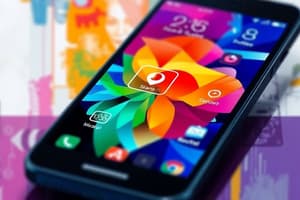Podcast
Questions and Answers
What is the primary mechanism by which a computer physically detects a new USB device?
What is the primary mechanism by which a computer physically detects a new USB device?
- A change in electrical current
- Radio signals sent by the device
- A change in voltage on the USB bus (correct)
- A unique identifier assigned to the device
What is the standardized method used by most modern devices for automatic device recognition?
What is the standardized method used by most modern devices for automatic device recognition?
- Device Identification
- Driver Matching
- Hardware Detection
- Plug and Play (PnP) (correct)
What is the purpose of the Class Code during the PnP handshake?
What is the purpose of the Class Code during the PnP handshake?
- To identify the specific device model
- To assign a unique identifier to the device
- To specify the manufacturer of the device
- To identify the general category of the device (correct)
Where does the OS search for a suitable driver during the device recognition process?
Where does the OS search for a suitable driver during the device recognition process?
What is the primary purpose of the Device ID during the device recognition process?
What is the primary purpose of the Device ID during the device recognition process?
What establishes a connection between a Bluetooth device and the computer's Bluetooth adapter?
What establishes a connection between a Bluetooth device and the computer's Bluetooth adapter?
Flashcards are hidden until you start studying
Study Notes
Hardware Detection
- When connecting a new device (e.g., USB printer, Bluetooth headphones), the computer physically detects the change in hardware.
- USB devices signal the computer to the new connection through a change in voltage on the USB bus.
- Bluetooth devices establish a connection by sending out radio signals that the computer's Bluetooth adapter picks up.
Plug and Play (PnP)
- PnP is a standardized method for automatic device recognition.
- The device and OS exchange information during the PnP handshake.
- The device broadcasts information, including its device ID, class code, and vendor ID.
Device Identification
- Device ID is a unique identifier assigned to the device by the manufacturer.
- Class code identifies the general category of the device (e.g., printer class, storage device class).
- Vendor ID specifies the manufacturer of the device.
Driver Matching
- The OS uses the device information to search for a suitable driver.
- The OS might have generic drivers for common device types stored in its driver database.
- The OS might connect to online repositories (like Windows Update) to download and install the latest driver for the specific device.
Additional Considerations
- Legacy devices might not support PnP and require manual driver installation.
- Driver signing is used for security reasons, where the driver is digitally signed by a trusted source (usually the manufacturer) to ensure its legitimacy.
Studying That Suits You
Use AI to generate personalized quizzes and flashcards to suit your learning preferences.




